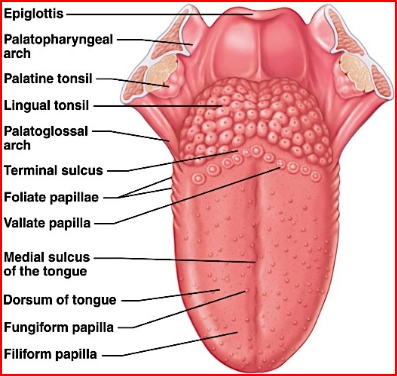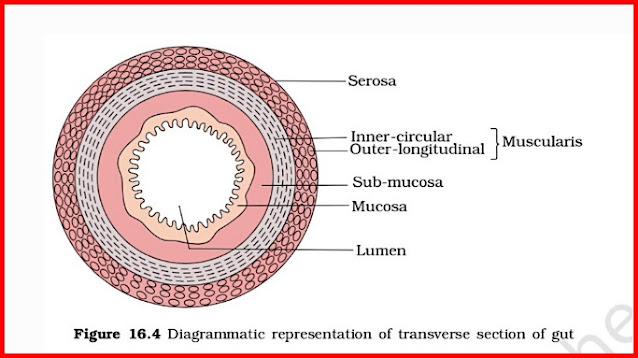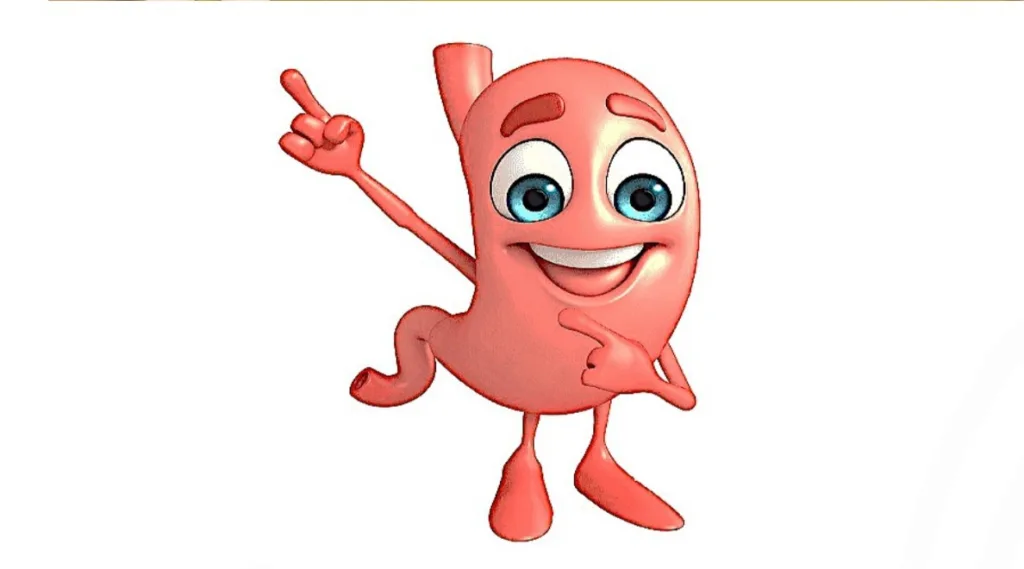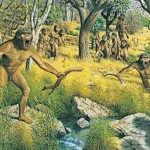DIGESTION & ABSORPTION
1. Food –> Carbohydrates, Proteins and Fats. (Have Calorific value)
• Vitamins and Minerals (Non calorific value but important)
• Food is source of energy –>for growth and repair of tissues.
• The water plays an important role in metabolism

2. Biomacromolecules
• Not utilized by body as such so –>Digestion needed
3. Digestion
• Macromolecules broken down and converted into simple substances
• conversion of complex food substances to simple absorbable forms
• carried out by our digestive system by mechanical and biochemical methods. This by
• Digestion is hydrolysis of food.
• Digestion in human(and from Platyhelminthes to all phylum chordates) is extracellular.
• Coelenterates also have extracellular digestion.
4. The human digestive system consists of
• The alimentary canal and
• The associated glands.
5. Alimentary Canal
• The alimentary canal begins with an anterior opening – the mouth, and it opens out posteriorly through the anus.
• On the basis of embryonic origin vertebrate alimentary canal is divided into three parts-
• Fore gut/stomodaeum- It is ectodermal in origin. It includes buccal cavity, pharynx, oesophagus stomach and small part of duodenum.
• Mid gut – /Mesodaeum Endodermal origin and it includes small and large intestine.
• Hind gut/Proctodaeum -Ectodermal in origin and it includes anal canal and anus.
• Duodenum is part of small intestine and it has ectodermal and endodermal origin. This content developed by
6. The mouth leads to the buccal cavity or oral cavity.
7. The oral cavity has
• a number of teeth and
• a muscular tongue.
8. Each tooth is embedded in a socket of jaw bone Thecodont teeth
9. In human being forms two sets of teeth during their life Diphyodont teeth
• a set of temporary milk or deciduous teeth
• a set of permanent or adult teeth.
10. An adult human has
• 32 permanent teeth
• Four different types
Heterodont dentition
incisors (I), canine (C), premolars (PM) and molars (M).
• Dental formula –> Arrangement of teeth in each half of the upper and lower jaw ( I, C, PM, M)

In human –>2123 / 2123.
In child (deciduous teeth)-212/212.
Both childhood molar are replaced by premolars.
• Enamel –> The hard-chewing surface of the teeth
Helps in the mastication of food @ (Mechanical Process).
Odontoblast cell in tooth is mesodermal in origin and line the pulp cavity and responsible for forming dentine of tooth.
Dentine is layer of inorganic substance and surrounds the odontoblast cells.
Enamel is secreted by ameloblast /enameloblast cells. This content developed by
11. Tongue:

• Freely movable muscular organ
• Attached to the floor of the oral cavity by the frenulum.
• The upper surface has small projections called papillae, some of which bear taste buds.
• In dog, tongue help in regulation of tempreture.This phenomenon called Panting.

12. Pharynx
• The oral cavity leads into a short pharynx
• Serves as a common passage for food and air.
• The oesophagus and the trachea (wind pipe) open into the pharynx.
• A cartilaginous flap called EPIGLOTTIS prevents the entry of food into the glottis – opening of the wind pipe – during swallowing.

13. Oesophagus
• A thin, long tube
• Extends posteriorly.
• It opens in pharynx through gullet and posteriorly into stomach through cardiac orifice.
• Serosa is absent in oesophagus and outermost layer is of connective tissue and called Tunica adventitia.
• Oesophagus lacks digestive glands but has submucosa mucosal glands which make submucosa thickest in alimentary canal.
• Passing through the neck, thorax and diaphragm
• Leads to a ‘J’ shaped bag like structure called stomach.
• A muscular sphincter (gastro-oesophageal) regulates the opening of oesophagus into the stomach. This content developed by https://sciencegajab.com/

14. Stomach
• Located in the upper left portion of the abdominal cavity
• Has four parts –

1.a CARDIAC PORTION into which the oesophagus opens through gullet/cardiac sphincter valve.
2.a FUNDIC REGION and
3. a BODY–>Main central region
4.a PYLORIC PORTION which opens into the first part of small intestine through pyloric sphincter valve.
Due to less development of cardiac sphincter, that is why regurgitation is common in new born.
Anterior part of stomach has cardiac gastric gland which has mucous neck cell secreting mucous.
Middle part of stomach has following type of cells –
1-Peptic/zymogen/chief/central cell which secrete proenzyme pepsinogen and prorenin.
2-Oxyntic /paretial cell which secrete HCL and castle intrinsic factor. Intrinsic factor is required for absorption of vitamin B12 which is required for erythropoiesis.
3- Mucous canal cell which secrete alkaline mucous.
4-Argentaffin/Kultchitsky/enterochromaffin cells which secretes serotonin.
Posterior part of stomach has G cells /gastrin which gastrin hormone which increase gastric gland secretion.
15. Small intestine
• Divided into three regions,
1.a ‘C’ shaped (in Humans); ‘U’ Shaped (in Rabbit) duodenum,
2.a long coiled middle portion jejunum
3.a highly coiled ileum.

• The opening of the stomach into the duodenum is guarded by the PYLORIC SPHINCTER.
• Pancreas is located in U shape of duodenum.
• Duodenum has Bruner gland (in submucosa) secretes mucous.
• Duodenum and ileum has crypt of Lieberkühn (folding of lamina propia)also called intestinal gland which secretes succus entericus (intestinal juice).
• Payers patches is lymphatic nodules produces lymphocytes.
• Ileum opens into the large intestine.
• Small intestine is longest part of alimentary canal.
• Small intestine performs function of absorption and digestion.

16. Large intestine
• It consists of
Caecum -Its posterior end is present as blind sac called vermiform appendix. It is vestigial in human. In herbivore, it digests the cellulose.It opens into colon.
COLON-The colon is divided into three part.
1.An Ascending,
2.A Transverse And
3.A Descending Part.
• The descending part opens into the rectum which opens out through the anus.

• Colon bacteria synthesize Vitamin B12 and vitamin K.
17. THE WALL OF ALIMENTARY CANAL
• All most similar from oesophagus to rectum
• Possesses four layers namely
1.Serosa,
2.Muscularis,
3.Sub-mucosa and
4.Mucosa.
• Serosa
* the outermost layer
* made up of a thin mesothelium (epithelium of visceral organs) with some connective tissues.
• Muscularis
*formed by smooth muscles
* usually arranged into
1. an inner circular and
2 . an outer longitudinal layer.
* An oblique muscle layer may be present in some regions.
• Submucosal layer
* formed of loose connective tissues containing nerves, blood and lymph vessels.
* In duodenum, glands are also present in sub-mucosa.
• Mucosa
* The innermost layer
* Lining the lumen of the alimentary canal
* This layer forms
1. irregular folds (rugae) in the stomach
2. small finger-like foldings called villi in the small intestine
The cells lining the villi produce numerous microscopic projections MICROVILLI
1. Giving a brush border appearance.
2. Increase the surface area enormously.
Villi are supplied with a network of capillaries and a large lymph vessel called the LACTEAL.
Mucosal epithelium has GOBLET CELLS
Goblet cells secrete mucus help in lubrication.
Mucosa also forms glands in the stomach (gastric glands) and crypts in between the bases of villi in the intestine (crypts of Lieberkuhn).
All the four layers show modifications in different parts of the alimentary canal.
18. Digestive Glands
• Glands associated with the alimentary canal–>Digestive glands
• These are
1.The salivary glands,
2. The liver and
3.The pancreas.
19. Salivary Glands
• Three pairs of salivary glands,
1.the parotids (cheek),
2. the sub-maxillary/sub-mandibular (lower jaw) and
3. the sublingual (below the tongue).
• These glands situated just outside the buccal cavity secrete salivary juice into the buccal cavity. (Saliva is mainly produced)

20. Liver
• Largest gland of the body
• Weighing about 1.2 to 1.5 kg in an adult human.
• It is situated
in the abdominal cavity,
just below the diaphragm
• THE HEPATIC LOBULES
The structural and functional units of liver
Containing hepatic cells arranged in the form of cords.
Between the cords, blood sinusoids are present lined by incomplete endothelium with scattered KUPFFER CELLS which is phagocytotic and eat bacteria and foreign substance.
Hepatic cells are rich in glycogen.
A network of tubular space between the hepatocytes is called bile canaliculi and this canaliculus empty into hering canal and these canals lead into bile duct.
Each lobule is covered by a thin connective tissue sheath called the GLISSON’S CAPSULE.
Hering canal, Kupffer cells, falciform ligament are found in liver.
Left and right hepatic duct join to form common hepatic duct and then cystic duct from gall bladder join them and form common bile duct/Ductus cholidochus/CBD.
CBD passes downward and join the main pancreatic duct and form Hepatopancreatic ampulla (Ampulla of Vater)/common hepatopancreatic duct which open into duodenum and this opening is guarded by Sphincter of ODDI.
Sphincter of boydon surrounds the CBD just before joinig with pancreatic duct.
pH of pancreatic juice alkaline.
Pancreatic juice has amylase,trypsin,chymotrypsin corboxypeptidaselipase,DNAase and RNAase and these enzymes site of action is small intestine.
• FUNCTION OF LIVER:
o Site of glycogenesis that conversion of glucose into glycogen with help of insulin secreted by beta cells of pancreas.
o Site of glycogenolysis that is conversion of glycogen into glucose with help of glucagon hormone secreted by alpha cells of pancreas.
o Site of GLUCONEOGENESIS that is conversion of protein and fat into glucose.
o Site of lipogenesis that is excess glucose converted into fat and stored in liver cell.
o It secretes bile which is stored in Gall bladder.
o Embryonic liver is site of erythropoiesis.
o Fibrinogen and prothrombin formation and storage of heparin (anticoagulant).
o Synthesis of vitamin A.
Pancreas
• A compound elongated organ
• situated between the limbs of the ‘C’ shaped duodenum.
• Have both exocrine and endocrine portions
• The exocrine portion
secretes an alkaline pancreatic juice containing enzymes.
Pancreatic juice has amylase,trypsin,chymotrypsin corboxypeptidaselipase,DNAase and RNAase and these enzymes site of action is small intestine.
• The endocrine portion
secretes hormones, insulin by beta cells and glucagon by alpha cells, somatostatin by delta cells and pancreatic polypeplide by F cells .
Polypeplide inhibite secretion of pancreatic juice while somatostatin inhibite the rate of nutrient absorption from gastrointestinal tract.
21. DIGESTION OF FOOD
• Involves mechanical and chemical processes.
• The buccal cavity performs two major functions,
1.Mastication of food and
2. Facilitation of swallowing.
• The teeth and the tongue with the help of saliva masticate and mix up the food thoroughly.
• Role of mucus in saliva
helps in lubricating and adhering the masticated food particles into a BOLUS.
• The bolus is then conveyed into the pharynx and then into the oesophagus by swallowing or deglutition.
• The bolus further passes down through the oesophagus by successive waves of muscular contractions called PERISTALSIS.
• The gastro-oesophageal sphincter controls the passage of food into the stomach.
• The saliva secreted into the oral cavity contains electrolytes and enzymes, salivary amylase and lysozyme.
• The chemical process of digestion is initiated in the oral cavity by the hydrolytic action of the carbohydrate splitting enzyme, the salivary amylase.
• About 30 per cent of starch is hydrolysed here by this enzyme (optimum pH 6.8) into a disaccharide – maltose.
• LYSOZYME present in saliva acts as an antibacterial agent that prevents infections.
• The mucosa of stomach has gastric glands.
• Gastric glands have three major types of cells namely –
1.Mucus neck cells which secrete mucus;
2. Peptic or chief cells which secrete the proenzyme pepsinogen
3. Parietal or oxyntic cells which secrete HCl and intrinsic factor
1. Intrinsic factor essential for absorption of vitamin B12
• The stomach stores the food for 4-5 hours.
• The food mixes thoroughly with the acidic gastric juice of the stomach by the churning movements of its muscular wall and is called the CHYME.
• The proenzyme pepsinogen, on exposure to HCl gets converted into the active enzyme pepsin, the proteolytic enzyme of the stomach.
• Pepsin converts proteins into proteoses and peptones (peptides).
• The mucus and bicarbonates present in the gastric juice play an important role in lubrication and protection of the mucosal epithelium from excoriation by the highly concentrated hydrochloric acid.
• HCl provides the acidic pH (pH 1.8) optimal for pepsins.
• RENNIN
a proteolytic enzyme
found in gastric juice of infants
helps in the digestion of milk proteins.
• Small amounts of lipases are also secreted by gastric glands.
• Pepsin convert casein into paracasein(curd) in adult.
• Pepsin, rennin in infant and lipase are the enzymes of gastric gland and their site of action is stomach.
• Gastrin hormone secreted by mucosa of pyloric stomach stimulate gastric juice secretion and constrics cardiac sphincter.
DIGESTION IN SMALL INTESTINE:
• Small intestine movements are generated by the muscularis layer
These movements help in a thorough mixing up of the food with various secretions in the intestine facilitate digestion.
• The bile, pancreatic juice and the intestinal juice are the secretions released into the small intestine.
• Pancreatic juice and bile are released through the hepato-pancreatic duct.
• The pancreatic juice contains inactive enzymes –
trypsinogen,
chymotrypsinogen,
procarboxypeptidases,
amylases, lipases and
nucleases.
• The bile released into the duodenum
• The bile contains
bile pigments (bilirubin and bili-verdin),
bile salts,
cholesterol and
phospholipids
• THE BILE ENZYMES ABSENT.
• Bile helps in emulsification of fats, i.e., breaking down of the fats into very small micelles.
• Bile activates lipases.
• The intestinal mucosal epithelium has goblet cells which secrete mucus.
• The mucus along with the bicarbonates from the pancreas protects the intestinal mucosa from acid as well as provide an alkaline medium (pH 7.8) for enzymatic activities. Sub-mucosal glands (Brunner’s glands) also help in this.
• These final steps in digestion occur very close to the mucosal epithelial cells of the intestine.
• The simple substances thus formed are absorbed in the jejunum and ileum regions of the small intestine.
• Intestinal glands in mammals is collective name for crypt of lieberkuhn (secrete alkaline juice) and Brunner’s gland (secrete mucous).
• Secretion of crypt of Lieberkühn and BRUNNER” S gland are stimulated by ENTEROCRININ HORMONE and DUOCRININ HORMONE of duodenal mucosa. These hormones secreted when acidic chyme reach in intestine.
• Intestinal juice/succus entericus has following enzymes.
• Enterokinase convert inactive trypsinogen into trypsin. Then trypsin converts chymotrypdsinogen into chymotrypsin.
• Chymotrypsin convert polypeptides into oligopeptides.
• Aminopeptidase convert peptides into smaller peptides and amino acids.
• Dipeptidase convert dipeptide into amino acids.
• Isomaltase convert isomaltase into glucose.
• Sucrose and invertase convert sucrose into glucose and fructose.
• Maltase convert maltose into glucose.
• Lipase convert triglycerides into monoglycerides and fatty acids.
• Lactase convert lactose into glucose and galactose.
• Nucleotidase convert nucleotides into nucleosides and inorganic phosphate.
• Nucleosidase convert nucleosides into nitrogenous base that is purines and pyrimidines and pentose sugar.
• Proteins, proteoses and peptones (partially hydrolysed proteins) in the chyme reaching the intestine are acted upon by the proteolytic enzymes of pancreatic jui
• Nucleases in the pancreatic juice acts on nucleic acids to form nucleotides and nucleosides
• The enzymes in the succus entericus act on the end products of the above reactions to form the respective simple absorbable forms.
HORMONAL CONTROL:
• When chyme enters in duodenum, Enterogastrone is secreted by duodenal epithelium and this hormone slow the gastric contraction and delay stomach emptying and inhibit secretion of gastric juice.
• Secretin is another hormone of duodenal epithelium origin and secretion is stimulated on entry of chyme in duodenum and its target organ is pancreas (release of sodium bi carbonate), liver (secretion of bile) and stomach (inhibition of gastric juice).
• CHOLECYSTOKININ of duodenum is released when fat is in duodenum and stimulate pancreas and gall bladder for secretion of pancreatic juice and bile respectively.
• Villikinin hormone from small intestine increase movement of villi.
• The undigested and unabsorbed substances are passed on to the large intestine –> NO SIGNIFICANT DIGESTIVE ACTIVITY OCCURS IN THE LARGE INTESTINE.
• The functions of large intestine are:
Absorption of some water, minerals and certain drugs;
Secretion of mucus which helps in adhering the waste (undigested) particles together and lubricating it for an easy passage.
• The undigested, unabsorbed substances called faeces
• Faeces enters into the caecum of the large intestine through ileo-caecal valve, which prevents the back flow of the faecal matter.
• Faeces temporarily stored in the rectum till defaecation.
22. Control Of Digestive System:
• Under neural and hormonal control
• The sight, smell and/or the presence of food in the oral cavity can stimulate the secretion of saliva.
• Gastric and intestinal secretions are also, similarly, stimulated by neural signals.
• The muscular activities of different parts of the alimentary canal can also be moderated by neural mechanisms, both local and through CNS.
• Hormonal control of the secretion of digestive juices is carried out by local hormones produced by the gastric and intestinal mucosa.
23. ABSORPTION OF DIGESTED PRODUCTS
• Absorption –> end products of digestion pass through the intestinal mucosa into the blood or lymph.
• It is carried out by passive, active or facilitated transport mechanisms.
• Simple diffusion –> Small amounts of monosaccharides like glucose, amino acids and some electrolytes like chloride ions
• Facilitated transport Some substances like glucose and amino acids are absorbed with the help of carrier proteins.
• Transport of water depends upon the osmotic gradient.
• Active transport occurs against the concentration gradient and hence requires energy. e.g. amino acids, monosaccharides like glucose, electrolytes like Na+ are absorbed into the blood by this mechanism.
• Fatty acids and glycerol being insoluble, cannot be absorbed into the blood. They are first incorporated into small droplets called MICELLES which move into the intestinal mucosa.
• They are re-formed into very small protein coated fat globules called the CHYLOMICRONS which are transported into the lymph vessels (lacteals) in the villi.
• These lymph vessels ultimately release the absorbed substances into the blood stream.
• Absorption of substances takes place in different parts of the alimentary canal, like mouth, stomach, small intestine and large intestine.
• HOWEVER, MAXIMUM ABSORPTION OCCURS IN THE SMALL INTESTINE.
• In mouth, normally there is no absorption but a few drugs like may be absorbed into blood through mucous membrane, if allowed to dissolve under the tongue. Example -Isoprenaline and Glyceryl trinitrate.
24. The absorbed substances finally reach the tissues which utilise them for their activities. This process is called ASSIMILATION.
25. DEFAECATION
• The egestion of faeces to the outside through the anal opening
• Faeces in the rectum initiate a neural reflex
• a voluntary process and
• is carried out by a mass peristaltic movement.

26. DISORDERS OF DIGESTIVE SYSTEM
• The inflammation of the intestinal tract is the most common ailment due to bacterial or viral infections.
• The infections are also caused by the parasites of the intestine like tapeworm, roundworm, threadworm, hookworm, pin worm, etc.
• JAUNDICE:
The liver is affected,
skin and eyes turn yellow due to the deposit of bile pigments.
• VOMITING:
ejection of stomach contents through the mouth.
This reflex action is controlled by the vomit centre in the medulla.
• DIARRHOEA:
The abnormal frequency of bowel movement
increased liquidity of the faecal discharge
It reduces the absorption of food.
• CONSTIPATION:
the faeces are retained within the rectum
the bowel movements occur irregularly.
• INDIGESTION:
the food is not properly digested
leading to a feeling of fullness.
The causes of indigestion are inadequate enzyme secretion, anxiety, food poisoning, over eating, and spicy food.
CALORIFIC VALUE OF PROTEIN, CARBOHYDRATE AND FAT
• The energy requirements of animals, and the energy content of food, are expressed in terms of measure of heat energy because heat is the ultimate form of all energies. This is often measured to as calorie (cal) or joule (J),
• It is the amount of heat energy required to raise the temperature of 1 g of water by 1 °C.
• Since this value is tiny amount of energy, physiologists commonly use kilocalorie (kcal) or kilo joule (kJ).
• One kilo calorie is the amount of energy required to raise the temperature of 1 kg of water by 1 °C.
• Nutritionists, traditionally refer to kcal as the Calorie or Joule (always
capitalised). The amount of heat liberated from complete combustion of 1 g food in a bomb calorimeter (a closed metal chamber filled with O2) is its gross calorific or gross energy value.
• The actual amount of energy combustion of 1 g of food is the physiologic value of food.
• Gross calorific values of carbohydrates, proteins and fats are
4.1 kcal/g, 5.65 kcal/g and 9.45 kcal/g, respectively, whereas their physiologic values are 4.0 kcal/g, 4.0 kcal/g and 9.0 kcal/g, respectively.




Pingback: Excretion - sciencegajab